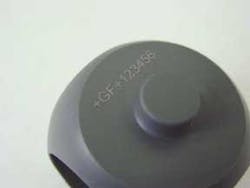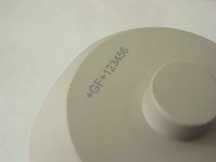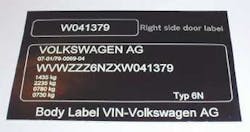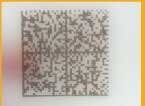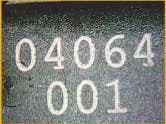Laser marking is not a new concept in the automotive manufacturing sector in Mexico, having been used there since the mid-1980s. The first applications included laser etching and paint engraving for backlit components such as faceplates, switches, and knobs for car stereos and mirror housings. Laser-based marking systems, which were an alternative to traditional marking methods, are now a standard for marking many plastics, metals, and composite subassemblies for the automotive industry. Laser marking of thermoplastics has taken longer to gain acceptance than expected in the last decade. Recently, however, new laser technology has renewed interest in lasers as a cost-effective solution for identification of plastics.
Figure 1. Thermoplastic gray and white housing marked with 3 Nd:Yag.
Several top-tier automotive manufacturers in Mexico have switched from traditional marking methods such as hot stamp and silk screening of plastics to laser marking. Lasers deliver digital to print with high precision and offer the possibility of real-time tracking of the manufacturing process. Plus, they provide added benefits over traditional marking methods. For instance, high-contrast, high-speed markings up to 1000dpi can be achieved with lasers. In addition, lasers can mark text, graphics, traditional 1D barcodes, and reduced space symbology codes such as 2D Data Matrix codes, which require high accuracy and resolution. Product traceability has become the driving force behind this technology.
So-called "nonaesthetic" applications are estimated to account for 90% of laser marking today. "Aesthetic" laser marking comprises approximately 10% of the market and has the potential for growth in replacing ink-based technologies. These are typically high-contrast markings produced with Nd:YAG lasers. The most widely accepted marking lasers for nonaesthetic marking of plastics in the automotive industry have been CO2 (carbon dioxide) lasers. Nd:YAG (yttrium aluminum garnet) lasers are used primarily for "aesthetic" marking but also fit into some "nonaesthetic" marking applications. Low-powered, air-cooled lasers on the order of 3 to 20 watts are becoming the choice for medium-volume, high-mix marking applications for plastics. Air-cooled lasers are very efficient and cost little to operate compared to high-powered, water-cooled, laser-based systems, and they take up much less space on the production line. Although Nd:YAG and CO2 technologies differ greatly, the concept is basically the same.
The laser utilizes a noncontact method of marking whereby the laser wavelength is absorbed into the material to cause a reaction. Reactions in plastics exhibit foaming, engraving, and color change; and sometimes a combination of all three. Lasers provide a permanent mark without touching the work piece or using consumables. They also can mark a wide variety of plastics that are not candidates for ink because of problems with adhesion or hot stamp due to mechanical constraints. Examples of successful applications include marking materials such as ABS, PP, PET and PVC, nylon, and PBT automotive connectors, just to name a few.
Fundamental CO2 lasers have a long thermal wavelength in the far infrared (10.6 um and 9.6 um), and the reaction on the material surface is mostly thermal. The CO2 wavelength causes a thermal overload on the surface of the material and the general effect is melting of the material to cause a desired color change or effect. The CO2 is relatively inexpensive and is good for marking some plastics. CO2 TEA (transverse excited atmospheric) lasers also are used for low-mix, high-volume marking applications that utilize mask plane imaging techniques to image a complete field at one time, eliminating the need for beam steering galvanometers associated with traditional marking systems. Although such lasers are desirable for high-speed lines, they are limited to smaller marking fields.
Figure 3. 2D on white polycarbonate marked with 3 watt laser.
Nd:YAG lasers at a wavelength of 1.06 um are exceptional for marking plastics. They can produce a finer resolution than CO2 lasers and, depending on the composition of the material, will derive different results than CO2. Diode-pumped, Q-switched, air-cooled Nd:YAGs can achieve very high peak power and at sufficiently short wavelengths such that a disassociation of molecules on the part surface results in a color change. Due to the short wavelength, the Nd:YAG wavelength is more easily absorbed into plastics than is the CO2 wavelength. Marking contrast can be enhanced with the addition of additives in the plastic molding injection process and recent advances have led to the option to derive different colors or multicolor laser marks. The additives are specific and formulated for plastics of various colors. Additives also have been formulated for CO2 wavelengths as well. Because any given material will react differently, the choice of laser will depend on such factors as the material properties of the plastic and the desired result.
Although the initial capital investment for a laser marking system can be significant over traditional marking technologies, lasers have proven that they pay off in the long run, not only in terms of cost savings with the offset of consumables and the low operating costs associated with air-cooled compact systems, but also in terms of the ability to track the manufacturing process inward to achieve more production efficiency and provide real-time feedback on the line. With the emergence of 2D codes in combination with automation and vision systems, lasers become a very powerful tool for the automotive supply chain. Because most lasers are operated from a PC interface, design changes are fast and easy to make, and many laser manufacturers build in controls for automation and for controlling the laser from a host controller. Recent advances in imaging now make it economically possible for manufacturers to adopt the (2D) Data Matrix code to the mix of current barcodes used in manufacturing. This reduced space symbology can track up to 100 times the amount of data or track the same data using only 2% of the labeling area of a traditional barcode with much greater accuracy and more information in a very robust code.
The AIAG (Automotive Industry Action Group) currently supports the 2D code. Automotive component vendors are using 2D to track keyless entry systems, radios, dashboard components, air bag system subassembly units, engine components, and more.
Mark Cavanaugh is a product manager for cab Technology, Inc., Tyngsboro, Mass. For more information, contact [email protected].
